WO/MXene for gas sensors
QQ Academic Group: 1092348845
Detailed

【Research Background】
The development of gas sensors capable of accurately detecting volatile organic compounds (VOCs) is of great importance in a wide range of fields including industrial safety control, environmental monitoring and personal health. Among many VOCs, acetone sensors have attracted more and more attention due to their application in health monitoring and self-diagnosis. For acetone sensors, metal oxides are the most widely used gas sensitive materials. Among them, tungsten oxide (WOx<3) has received special attention due to its excellent chemical stability, low cost, easy synthesis, structural diversity and controllability. However, the tungsten oxide gas sensor response is still relatively low and the detection limit is relatively high (>2 ppm), which is not suitable for health diagnosis. In order to improve the gas sensing performance, methods such as constructing a heterostructure, preparing a composite material, designing a novel sensor structure, doping, and the like can be employed. As an emerging two-dimensional material, MXene has a surface rich in functional groups and can be used as a site for gas adsorption, and has excellent prospects for gas sensing materials. In view of the reports of some existing MXene composite materials, it can be predicted that the composite materials of tungsten oxide and MXene should also have good gas sensitivity.
[Introduction]
Recently, Professor Chang Xueting from Shanghai Maritime University and Associate Professor Zhang Dongzhi from China University of Petroleum (East China) first reported the W18O49/Ti3C2Tx composite prepared by simple solvothermal method, and developed an acetone gas sensor based on this material. One-dimensional W18O49 nanorods are evenly distributed on the surface of two-dimensional Ti3C2Tx flakes to form a one-dimensional/two-dimensional W18O49/Ti3C2Tx composite. The W18O49/Ti3C2Tx composites have a significant improvement in the sensing properties of acetone. High response to low concentration acetone, fast response, good selectivity, good stability, and low detection limit of acetone. A new material is provided for the preparation of high performance acetone sensors.
The results are published online in Sensors and Actuators: B. Chemical: W18O49/Ti3C2Tx MXene nanocomposites for highly sensitive acetone gas sensor with low detection limit
[Graphic introduction]
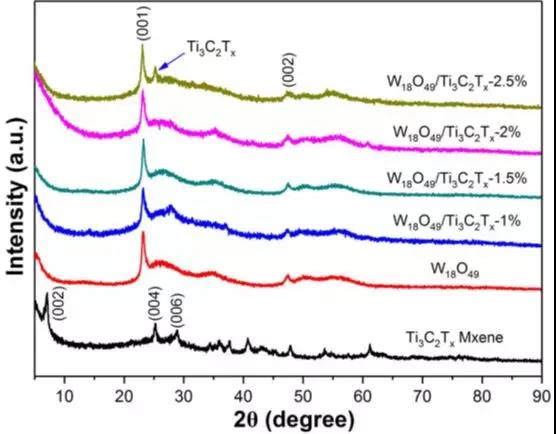
Figure 1 XRD patterns of Ti3C2Tx MXene sheets, W18O49 nanorods, and W18O49/Ti3C2Tx composites.

Figure 2 (a) SEM image of MXene sheet and (b) corresponding EDS element mapping of Ti, C, O and F. W18O49 nanorods (c, d) W18O49/Ti3C2Tx-1% (e, f), W18O49/Ti3C2Tx-1.5% (g, h), W18O49/Ti3C2Tx-2% (i, j) W18O49/Ti3C2Tx-2.5% ( SEM image of k, l).
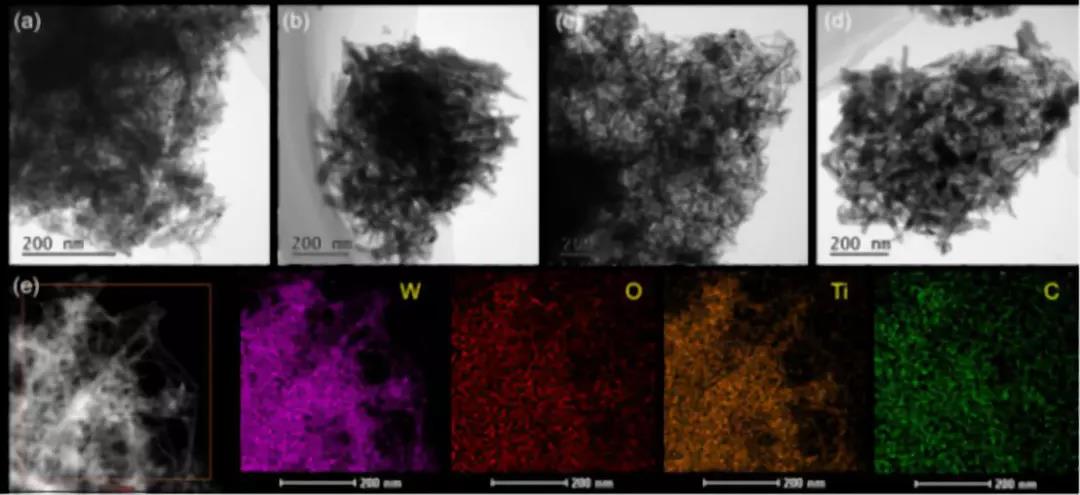
Figure 3 TEM image of W18O49/Ti3C2Tx-1% (a), W18O49/Ti3C2Tx-1.5% (b), W18O49/Ti3C2Tx-2% (c) W18O49/Ti3C2Tx-2.5% (d). (e) Element mapping of W18O49/Ti3C2Tx-2% selected regions W, O, Ti, and C.
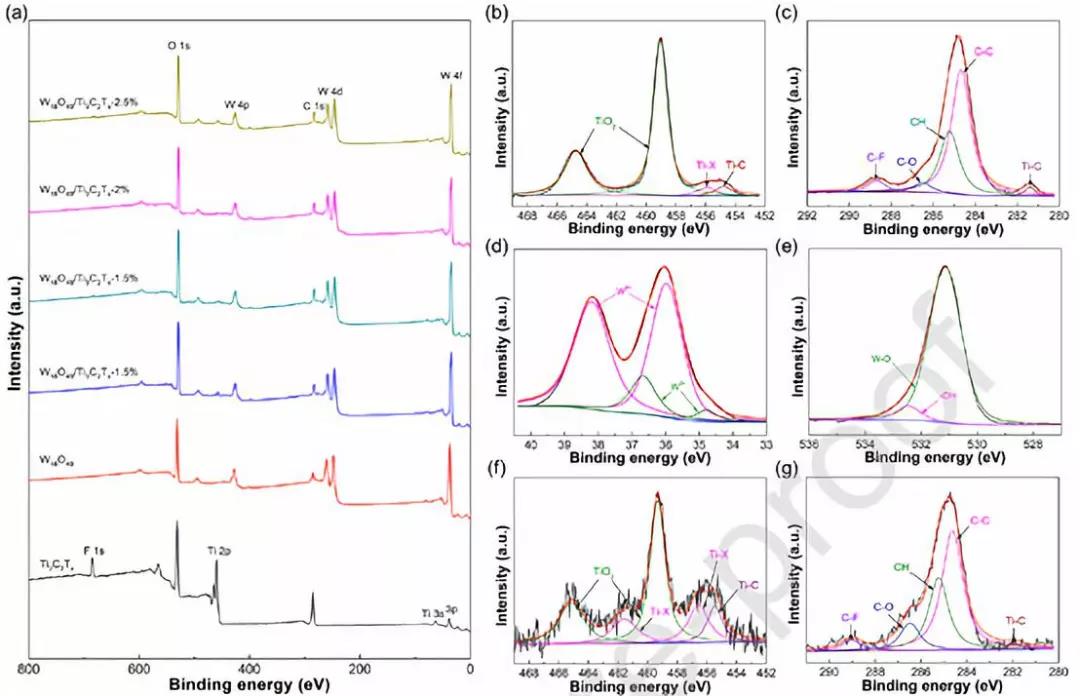
Figure 4 (a) XPS spectra of MXene sheets, W18O49 nanorods (c, d) and W18O49/Ti3C2Tx composites. (b) Deconvolution energy spectra of MXene sheets corresponding to Ti 2p and (c) C 1s . (d) Deconvoluted energy spectra of W18O49 nanorods corresponding to W 4f and (e) O 1s. (f) Deconvolution spectra of W18O49/Ti3C2Tx composites corresponding to Ti 2p and (g) C 1s .
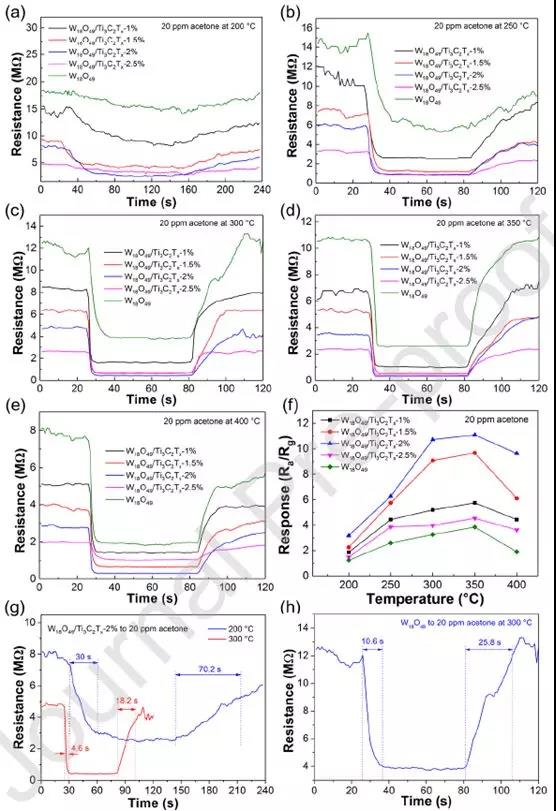
Figure 5. Response-recovery curves for different sensors versus 20 ppm acetone at (a) 200 °C, (b) 250 °C, (c) 300 °C, (d) 350 °C, and (e) 400 °C. (f) The response of different sensors to 20 ppm acetone as a function of operating temperature. (g) Response recovery time of W18O49/Ti3C2Tx-2% sensor to 20 ppm acetone at 200 °C and 300 °C. (h) Response recovery time of the W18O49 sensor to 20 ppm acetone at 300 °C.

Figure 6 (a) Response recovery curve for acetone from 0.17 to 500 ppm for different sensors at 300 °C. The internal picture is an enlarged view of the response recovery curve for 0.17-2 ppm acetone. (b, c) Response curves of different sensors to acetone concentration. (d) Cyclic response-recovery curve for W18O49/Ti3C2Tx-2% sensor versus 20 ppm acetone.
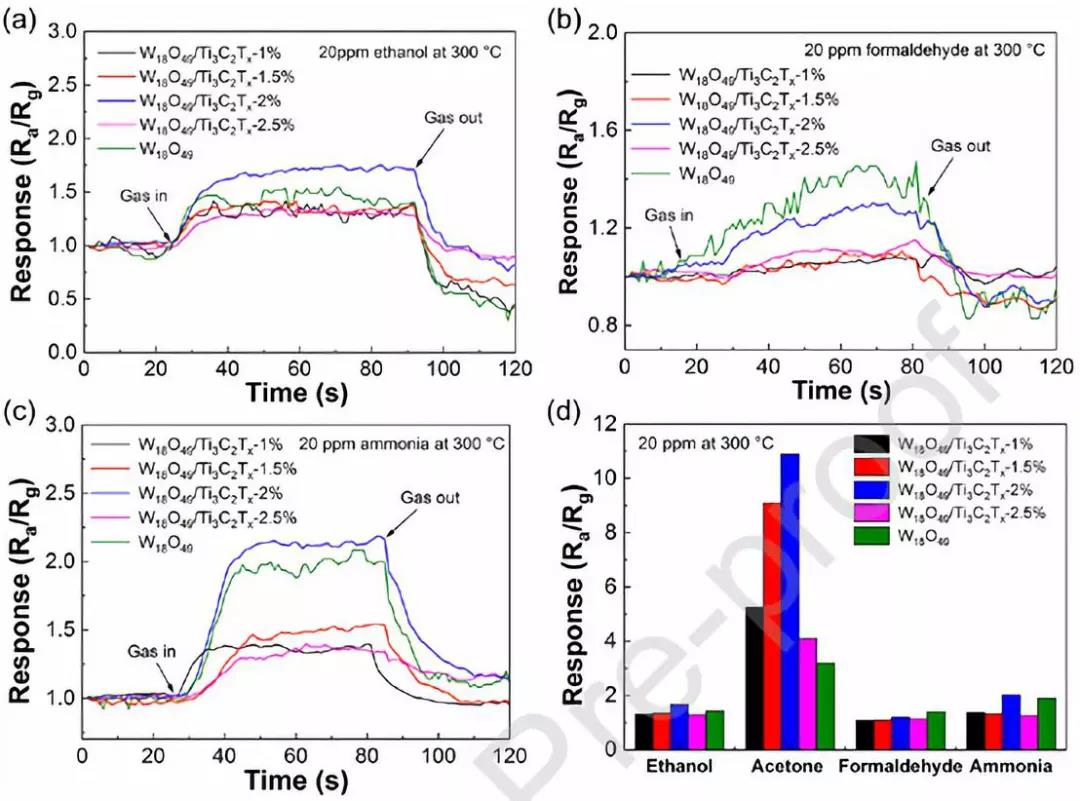
Figure 7. Response recovery curves of different sensors to 20 ppm of (a) ethanol, (b) formaldehyde, and (c) ammonia at 300 °C. (d) Comparison of different sensor responses for different gases.
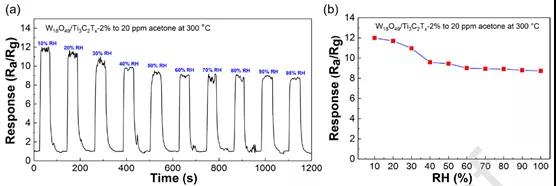
Figure 8 (a) Response recovery curve of the W18O49/Ti3C2Tx-2% sensor to 20 ppm acetone at 300 °C, and the response of the WBO49/Ti3C2Tx-2% sensor as a function of humidity.

Fig. 9 Schematic diagram of the reaction of acetone with W18O49/Ti3C2Tx composites (b)-(d) Schematic diagram of the energy difference of W18O49/Ti3C2Tx heterojunction under different conditions.
[Summary of this article]
This paper successfully synthesized W18O49/Ti3C2Tx composites. The W18O49/Ti3C2Tx composite with 2 wt% Ti3C2Tx exhibits the best acetone sensing performance with a response of 11.6 for 20 ppm acetone, a very low detection limit of 170 ppb acetone, and a fast response/recovery rate (5.6/). 6s to 170 ppb acetone). Compared with W18O49 and Ti3C2Tx sensors, W18O49/Ti3C2Tx sensor exhibits superior acetone sensing performance, which can be attributed to the uniform distribution of W18O49 nanorods on Ti3C2Tx surface, the removal of Ti3C2Tx fluorine group after hydrothermal process, and W18O49 nanorods and Synergistic interface interaction relationship of Ti3C2Tx films. One-dimensional/two-dimensional W18O49/Ti3C2Tx composites have potential applications in acetone sensors, and their synthesis can be extended to the preparation of other new gas sensing materials.
Literature link:
Https://doi.org/10.1016/j.snb.2019.127274
Source: WeChat public account MXene Frontier
- Previous: High performance MQW p
- Next: 1


 About us
About us